Pale Blue Dot at 30: Voyager 1's iconic photo of Earth from space reveals our place in the universe
The photo shows Earth as it truly is — a lonely outpost of life in an incomprehensibly vast cosmos.
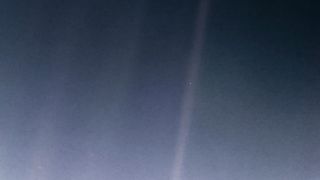
Thirty years ago today, humanity got a chance to see itself in a whole new light.
On Feb. 14, 1990, NASA's Voyager 1 probe snapped a photo of Earth from 3.7 billion miles (6 billion kilometers) away. The image shows our home planet as it truly is — a tiny, lonely outpost of life in an incomprehensibly vast cosmos — and became iconic as a result.
The Voyager 1 team sensed at the time that the " Pale Blue Dot ," as the photo has come to be known, would be an important social document, said planetary scientist Candy Hansen, who served as the experiment representative for the Voyager imaging team and was the first person to set eyes on the Pale Blue Dot photo when it came down to Earth.
Related: Voyager at 40: 40 photos from NASA's epic 'Grand Tour' mission
The Cold War had not yet thawed completely in early 1990. The Pale Blue Dot had the potential to remind folks around the world that we're all in this together, no matter how many nuclear warheads one superpower may be aiming at another, Hansen explained. And the image remains vital today, because its message is timeless, she added.
"Now, we have climate change as an existential threat," Hansen, who now works for the Arizona-based Planetary Science Institute, told Space.com. "And we need to remind ourselves again that there's one planet that is hospitable to humans. Even if we colonize the moon or Mars one day, neither one of those bodies is really going to be able to support seven billion of us. So, we need to take care of this planet."

A family portrait

Voyager 1 launched a few weeks after its twin, Voyager 2 , back in 1977. Together, the two probes conducted an unprecedented "grand tour" of the solar system's giant planets, flying by Jupiter, Saturn, Uranus and Neptune.
Get the Space.com Newsletter
Breaking space news, the latest updates on rocket launches, skywatching events and more!
The tour was over after the Neptune encounter, which Voyager 2 executed in August 1989. But the two spacecraft kept on flying, out toward the great unknown of interstellar space. Mission team members decided to turn off the two probes' cameras to save precious power during the long journey (and because they probably wouldn't have many chances to photograph interesting things out beyond Neptune anyway).
But Voyager 1 turned around to take one last look at home before closing its eyes. And not just its home planet — its home system. The probe took a "family portrait" series of 60 photos, capturing the sun, Venus, Jupiter, Saturn, Uranus and Neptune in addition to Earth. (Mercury was too close to the sun to be imaged, and sunlight bouncing around in the camera blocked Mars out.)
The Pale Blue Dot was the brainchild of famed astronomer, science communicator and Voyager imaging team member Carl Sagan , who first proposed snapping Earth with Voyager cameras in 1981 . And Sagan helped popularize the image and its message after the fact, writing a book called "Pale Blue Dot: A Vision of the Human Future in Space" (Random House, 1994).
Earth was one of the last things Voyager 1 saw. The probe took the Pale Blue Dot photo at 0448 GMT on Feb. 14, 1990, just 34 minutes before its cameras were shut off forever. (The very last photos Voyager 1 took, however, were of the sun, Hansen said.)
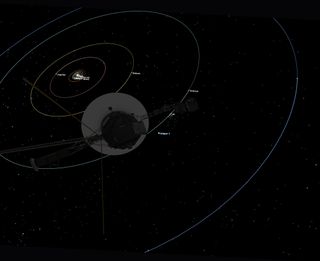
All of the image data didn't come down to Earth until May 1, 1990, NASA officials wrote in a Pale Blue Dot explainer . Hansen couldn't wait to see our planet through Voyager 1's eyes — and, when she finally got the chance, doing so proved a bit more difficult than she had expected.
"It was actually kind of terrifying, because I didn't see it at first," she said. "Because of that beam of scattered light, it didn't pop out at me immediately. And then I was so afraid that we had missed it, or screwed up the exposure or something. So, it was such a relief when I spotted it."
That beam of scattered light may have briefly stopped Hansen's heart, but it adds a certain poetic flair to the Pale Blue Dot photo. It's almost as if the cosmos threw a spotlight onto our precious little world for a moment, to help us make it out in the abyss.
Related: Earth quiz: Do you really know your planet?
Still exploring
Both Voyagers kept flying long after February 1990. They cruised through the outer solar system and eventually popped free of the sun's sphere of influence into interstellar space.
Voyager 1 accomplished this unprecedented feat in 2012 , and its twin followed suit six years later. And both probes are still going strong. They should have enough power left to continue gathering data about their exotic surroundings through 2024 or so, mission team members have said.
The Voyager program has accomplished amazing things, shedding considerable light on the giant planets and the dark realms far beyond them. (Voyager 2, for example, is still the only spacecraft ever to get up-close looks at Uranus or Neptune.) And the Pale Blue Dot is a unique part of this diverse and layered legacy.
"The Earth picture reaches to our hearts, I would say, and all the rest goes in our heads," Hansen said.
- Photos from NASA's Voyager 1 and 2 probes
- Voyager 1's historic flyby of Jupiter in photos
- Voyager 1 spacecraft's road to interstellar space: A photo timeline
Mike Wall's book about the search for alien life, " Out There " (Grand Central Publishing, 2018; illustrated by Karl Tate ), is out now. Follow him on Twitter @michaeldwall . Follow us on Twitter @Spacedotcom or Facebook .

OFFER: Save at least 56% with our latest magazine deal!
All About Space magazine takes you on an awe-inspiring journey through our solar system and beyond, from the amazing technology and spacecraft that enables humanity to venture into orbit, to the complexities of space science.
Join our Space Forums to keep talking space on the latest missions, night sky and more! And if you have a news tip, correction or comment, let us know at: [email protected].

Michael Wall is a Senior Space Writer with Space.com and joined the team in 2010. He primarily covers exoplanets, spaceflight and military space, but has been known to dabble in the space art beat. His book about the search for alien life, "Out There," was published on Nov. 13, 2018. Before becoming a science writer, Michael worked as a herpetologist and wildlife biologist. He has a Ph.D. in evolutionary biology from the University of Sydney, Australia, a bachelor's degree from the University of Arizona, and a graduate certificate in science writing from the University of California, Santa Cruz. To find out what his latest project is, you can follow Michael on Twitter.
Satellites watch as 4th global coral bleaching event unfolds (image)
Happy Earth Day 2024! NASA picks 6 new airborne missions to study our changing planet
Watch live today as NASA astronauts fly to launch site for 1st crewed Boeing Starliner mission to ISS
Most Popular
- 2 Stellar detectives find suspect for incredibly powerful 'superflares'
- 3 'Star Trek: Discovery' S05, E05 is a quality installment, but it's weighed down by another anchor of nostalgia
- 4 China launches 3 astronauts to Tiangong space station on Shenzhou 18 mission (video)
- 5 Across the universe, dark matter annihilation could be warming up dead stars
- A photo Photos 2.2k
- A stack of folders Collections 3.4k
- A group of people Users 114
Browse premium images on Unsplash+ | Claim your discount now
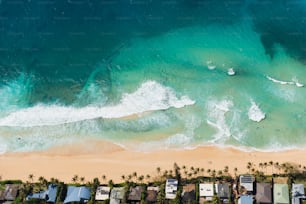
Make something awesome
- AI Generator
ocean voyage
Fantastic voyage, voyage ship, voyage icon, voyage logo, space voyage, maiden voyage, pirates voyage, voyage concept, voyage vintage, world voyage, blue voyage, self-driving voyage, valise voyage, 1,579,659 voyage stock photos & high-res pictures, browse 1,579,659 authentic voyage stock photos, high-res images, and pictures, or explore additional bon voyage or sea voyage stock images to find the right photo at the right size and resolution for your project..

/cdn.vox-cdn.com/uploads/chorus_image/image/66094266/82_EatingLickingDrinking_HermanEckelmann_NAIC.0.0.0.0.jpg)
Filed under:
The 116 photos NASA picked to explain our world to aliens
Share this story.
- Share this on Facebook
- Share this on Twitter
- Share this on Reddit
- Share All sharing options
Share All sharing options for: The 116 photos NASA picked to explain our world to aliens
If any intelligent life in our galaxy intercepts the Voyager spacecraft, if they evolved the sense of vision, and if they can decode the instructions provided, these 116 images are all they will know about our species and our planet, which by then could be long gone:
When Voyager 1 and Voyager 2 launched into space in 1977, their mission was to explore the outer solar system, and over the following decade, they did so admirably.
With an 8-track tape memory system and onboard computers that are thousands of times weaker than the phone in your pocket, the two spacecraft sent back an immense amount of imagery and information about the four gas giants, Jupiter, Saturn, Uranus, and Neptune.
But NASA knew that after the planetary tour was complete, the Voyagers would remain on a trajectory toward interstellar space, having gained enough velocity from Jupiter's gravity to eventually escape the grasp of the sun. Since they will orbit the Milky Way for the foreseeable future, the Voyagers should carry a message from their maker, NASA scientists decided.
The Voyager team tapped famous astronomer and science popularizer Carl Sagan to compose that message. Sagan's committee chose a copper phonograph LP as their medium, and over the course of six weeks they produced the "Golden Record": a collection of sounds and images that will probably outlast all human artifacts on Earth.
How would aliens know what to do with the Golden Record?
The records are mounted on the outside of Voyager 1 and Voyager 2 and protected by an aluminum case. Etched on the cover of that case are symbols explaining how to decode the record. Put yourself in an extraterrestrial's shoes and try to guess what the etchings seek to communicate. Stumped? Hover over or click on the yellow circles for the intended meaning of these interstellar brain teasers:

What else is on the Golden Record?
Any aliens who come across the Golden Record are in for a treat. It contains:
- 116 images encoded in analog form depicting scientific knowledge, human anatomy, human endeavors, and the terrestrial environment. (These images appear in color in the video above, but on the record, all but 20 are black and white.)
- Spoken greetings in more than 50 languages.
- A compilation of sounds from Earth.
- Nearly 90 minutes of music from around the world. Notably missing are the Beatles, who reportedly wanted to contribute "Here Comes the Sun" but couldn't secure permission from their record company. For the video above, I chose to include "Dark Was the Night" by Blind Willie Johnson, a 1927 track Sagan described as "haunting and expressive of a kind of cosmic loneliness."
The committee also made space for a message from the president of the United States:
:no_upscale()/cdn.vox-cdn.com/uploads/chorus_asset/file/4249653/carter.0.jpg)
Where are they now?
Incredibly, Voyager 1 and Voyager 2 are still communicating with Earth — they aren't expected to lose power until the 2020s. That's how NASA knew that Voyager 1 became the first ever spacecraft to enter interstellar space in 2012: The probe detected high-density plasma characteristic of the space beyond the heliosphere (the bubble of solar wind created by the sun).
Voyager 2 is currently traveling through the outer layers of the heliosphere. It's moving southward relative to Earth's orbit, while Voyager 1 is moving northward. In more than 40,000 years, they will each pass closer to another star than they are to our sun. (Or, more accurately, stars will pass by them).
There are three other spacecraft headed toward interstellar space; two of them, Pioneer 10 and Pioneer 11, are shown in this somewhat dated illustration:
NASA launched Pioneer 10 and 11 in 1972 and 1973, and has since lost communication with both. They aren't traveling as fast as the Voyagers, but they will eventually enter interstellar space as well.
They too, carry a message for extraterrestrial life, in the form of a 6-by-9-inch gold-anodized aluminum plaque, designed by Sagan and other members of the team that would go on to create the Voyager Golden Record five years later.
:no_upscale()/cdn.vox-cdn.com/uploads/chorus_asset/file/4252067/GPN-2000-001621-x.0.jpg)
Like the Golden Record, the plaque features the pulsar map, uses hydrogen to define the binary units, and depicts humankind. NASA faced a backlash for the nudity of the human figures.
Another interstellar message
The fifth probe that will exit our solar system is New Horizons , the spacecraft that flew by Pluto in 2015. It is headed in a broadly similar direction as Voyager 2, but having launched in 2006, it's many years behind. It may not reach interstellar space for another 30 years.
New Horizons was sent into space without any message like the Golden Record, but it's not too late to add one. A group led by Jon Lomberg , a member of Sagan's Golden Record team, is trying to convince NASA to upload a crowdsourced message to the probe for any intelligent life that might come across it.
The spacecraft's memory system is similar to a flash drive, and it wouldn't be as durable as the copper records on Voyager. "The most conservative estimates are a lifetime of a few decades. Other physicists and engineers believe the message might remain for centuries or even millennia," says the website of the message initiative, adding, more hopefully, "Another unknown is the advanced technology possessed by any ETs who find the spacecraft. They might have ways of reading the faded memory we cannot yet imagine."
Will you support Vox today?
We believe that everyone deserves to understand the world that they live in. That kind of knowledge helps create better citizens, neighbors, friends, parents, and stewards of this planet. Producing deeply researched, explanatory journalism takes resources. You can support this mission by making a financial gift to Vox today. Will you join us?
We accept credit card, Apple Pay, and Google Pay. You can also contribute via
You need $500. How should you get it?
The lies that sell fast fashion, streaming got expensive. now what, sign up for the newsletter today, explained, thanks for signing up.
Check your inbox for a welcome email.
Oops. Something went wrong. Please enter a valid email and try again.
Voyager Image Gallery
45 years of voyager i and ii.
Launched in 1977, NASA’s twin Voyager spacecraft inspired the world with pioneering visits to Jupiter, Saturn, Uranus, and Neptune. Their journey continues 45 years later as both probes explore interstellar space, the region outside the protective heliosphere created by our Sun. Researchers – some younger than the spacecraft – are now using Voyager data to solve mysteries of our solar system and beyond.

This archival photo shows engineers working on vibration acoustics and pyro shock testing of NASA’s Voyager on Nov. 18, 1976.

NASA’s Voyager 1 acquired this image of a volcanic explosion on Io on March 4, 1979, about 11 hours before the spacecraft’s closest approach to the moon of Jupiter.

This updated version of the iconic "Pale Blue Dot" image taken by the Voyager 1 spacecraft uses modern image-processing software and techniques to revisit the well-known Voyager view while attempting to respect the original data and intent of those who planned the images.

This illustrated graphic was made to mark Voyager 1’s entry into interstellar space in 2012. It puts solar system distances in perspective, with the scale bar in astronomical units and each set distance beyond 1 AU (the average distance between the Sun and Earth) representing 10 times the previous distance.

This graphic highlights some of the Voyager mission’s key accomplishments. Credit: NASA/JPL-Caltech Full image details

This graphic provides some of the mission’s key statistics from 2018, when NASA’s Voyager 2 probe exited the heliosphere. Credit: NASA/JPL-Caltech Full image details
- Images home
- Editorial home
- Editorial video
- Premium collections
- Entertainment
- Premium images
- AI generated images
- Curated collections
- Animals/Wildlife
- Backgrounds/Textures
- Beauty/Fashion
- Buildings/Landmarks
- Business/Finance
- Celebrities
- Food and Drink
- Healthcare/Medical
- Illustrations/Clip-Art
- Miscellaneous
- Parks/Outdoor
- Signs/Symbols
- Sports/Recreation
- Transportation
- All categories
- Shutterstock Select
- Shutterstock Elements
- Health Care
- Sound effects
PremiumBeat
- PixelSquid 3D objects
- Templates Home
- Instagram all
- Highlight covers
- Facebook all
- Carousel ads
- Cover photos
- Event covers
- Youtube all
- Channel Art
- Etsy big banner
- Etsy mini banner
- Etsy shop icon
- Pinterest all
- Pinterest pins
- Twitter All
- Twitter Banner
- Infographics
- Zoom backgrounds
- Announcements
- Certificates
- Gift Certificates
- Real Estate Flyer
- Travel Brochures
- Anniversary
- Baby Shower
- Mother's Day
- Thanksgiving
- All Invitations
- Party invitations
- Wedding invitations
- Book Covers
- About Creative Flow
- Start a design
AI image generator
- Photo editor
- Background remover
- Collage maker
- Resize image
- Color palettes
Color palette generator
- Image converter
- Creative AI
- Design tips
- Custom plans
- Request quote
- Shutterstock Studios
- Data licensing
You currently have 0 credits
See all plans

Image plans
With access to 400M+ photos, vectors, illustrations, and more. Includes AI generated images!

Video plans
A library of 28 million high quality video clips. Choose between packs and subscription.

Music plans
Download tracks one at a time, or get a subscription with unlimited downloads.
Editorial plans
Instant access to over 50 million images and videos for news, sports, and entertainment.
Includes templates, design tools, AI-powered recommendations, and much more.
Voyage royalty-free images
916,049 voyage stock photos, vectors, and illustrations are available royalty-free for download..
Our company
Press/Media
Investor relations
Shutterstock Blog
Popular searches
Stock Photos and Videos
Stock photos
Stock videos
Stock vectors
Editorial images
Featured photo collections
Sell your content
Affiliate/Reseller
International reseller
Live assignments
Rights and clearance
Website Terms of Use
Terms of Service
Privacy policy
Modern Slavery Statement
Cookie Preferences
Shutterstock.AI
AI style types
Shutterstock mobile app
Android app
© 2003-2024 Shutterstock, Inc.

- The Contents
- The Making of
- Where Are They Now
- Frequently Asked Questions
- Q & A with Ed Stone
golden record
Where are they now.
- frequently asked questions
- Q&A with Ed Stone
galleries / images voyager took
Images voyager took of uranus.
NASA's Voyager 2 spacecraft flew closely past distant Uranus, the seventh planet from the Sun, in January. At its closet, the spacecraft came within 81,800 kilometers (50,600 miles) of Uranus's cloudtops on Jan. 24, 1986. Voyager 2 radioed thousands of images and voluminous amounts of other scientific data on the planet, its moons, rings, atmosphere, interior and the magnetic environment surrounding Uranus.
For a fact sheet on the Uranus science summary, click here .
False-color view of Uranus.
Uranus’s outermost ring., uranus’s moon miranda., true-color (left) and false-color views of uranus. january 17, 1986. range 5.7 million miles..
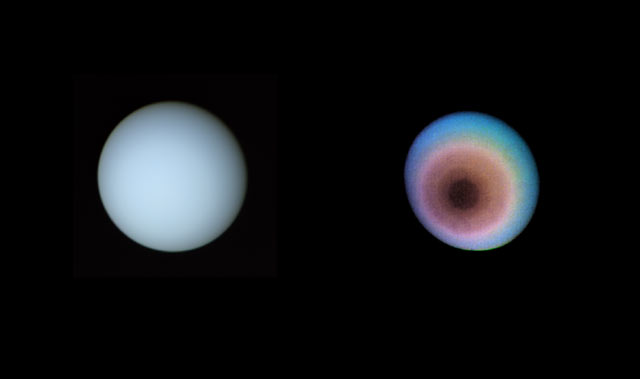

False-color composite of Uranus shows discrete cloud. January 14, 1986. Range, 8.0 million miles.
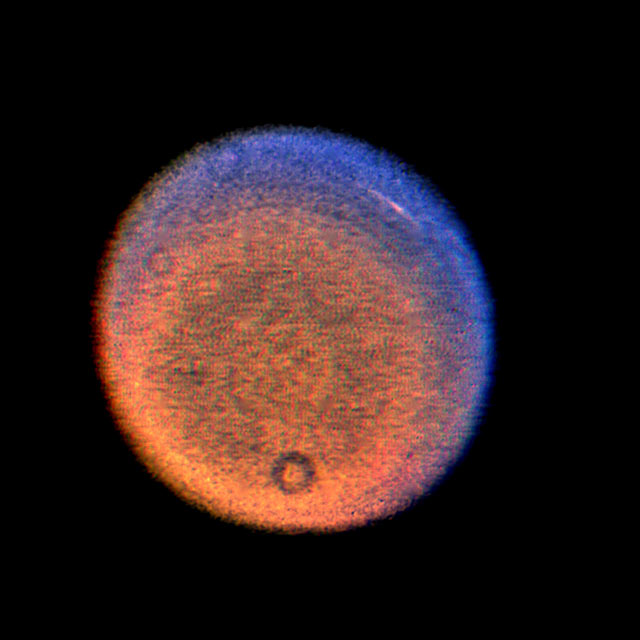
Time-lapse images show cloud movements in Uranus’s atmosphere over 4.6-hour interval.
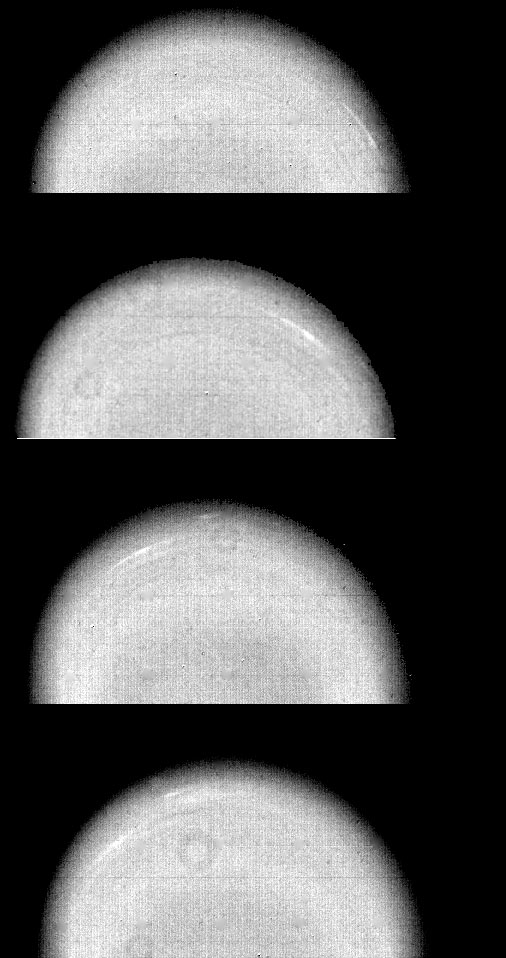
Farewell shot of crescent Uranus as Voyager 2 departs. January 25, 1986. Range 600,000 miles.
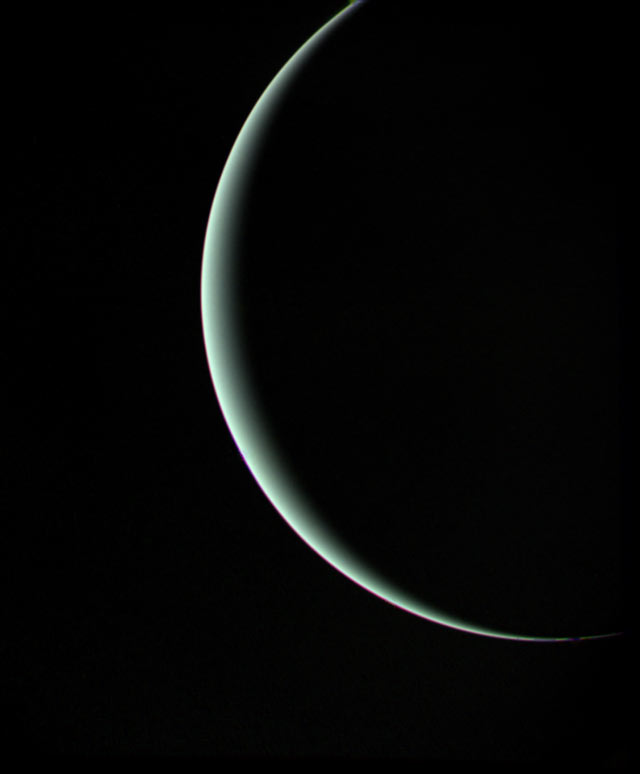
Three of the moons discovered by Voyager 2: 1986U1, 1986U3, and 1986U4. January 18, 1986. Range 4.8 million miles.
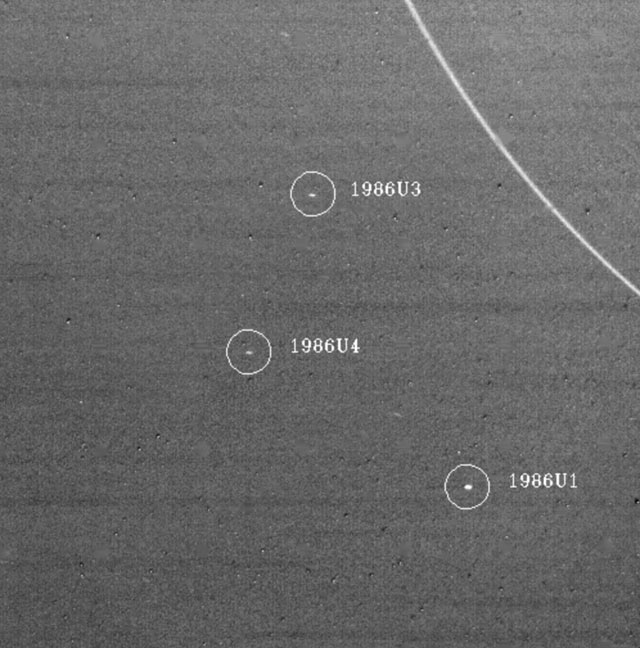
Two "shepherd" moons, 1986U7 and 1986U8, with epsilon ring. January 21, 1986. Range, 2.5 million miles.
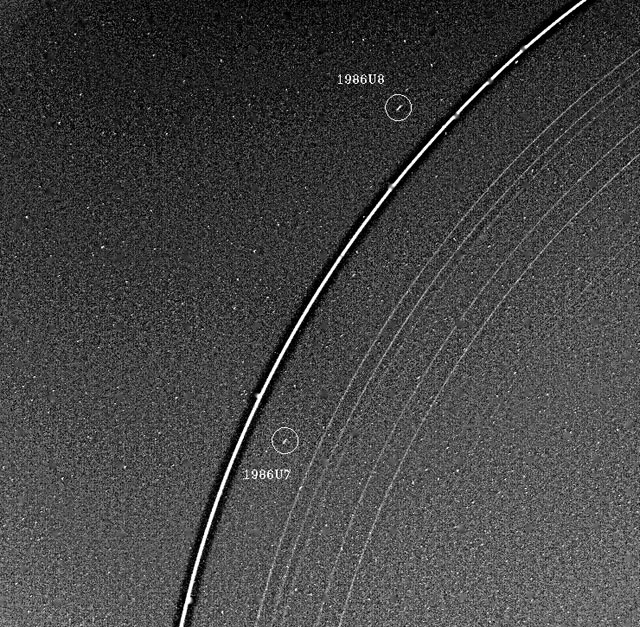
False-color composite of Uranus’s rings (from top): epsilon, delta, gamma, eta, beta, alpha, 4, 5 and 6. January 21 1986. Range, 2.6 million miles.

Rings of Uranus, including newly discovered 10th ring designated 1986U1R (barely visible below outermost epsilon ring). January 23, 1986. Range, 690,000 miles.
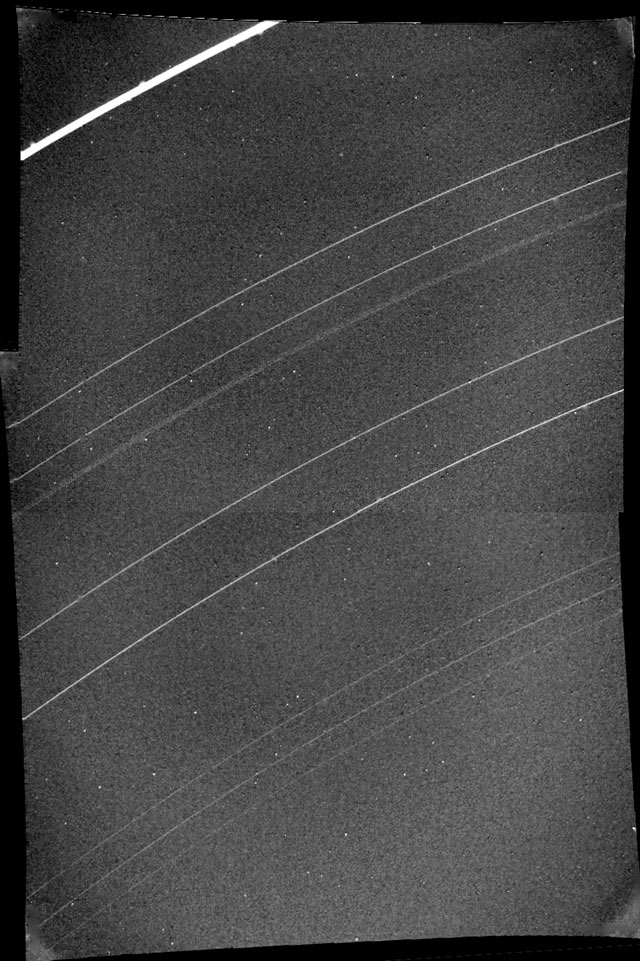
Backlit view shows continuous distribution of fine particles throughout ring system. January 24, 1986. Range, 147,000 miles.

Heavy crate ring seen in most detailed view of Umbriel. January 24, 1986. Range, 346,000 miles.
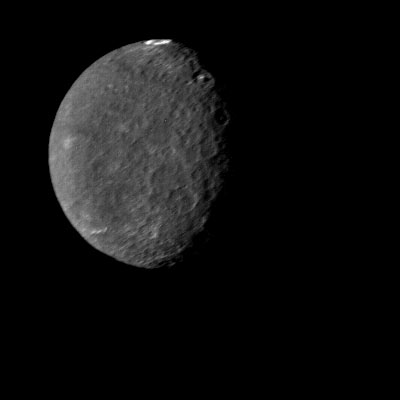
Best image of Oberon shows cratering and large peak on moon’s lower limb. January 24, 1986. Range 410,000 miles.

Mosaic of Ariel, most detailed view from Voyager 2 shows numerous faults and valleys. January 24, 1986. Range, 80,000 miles.
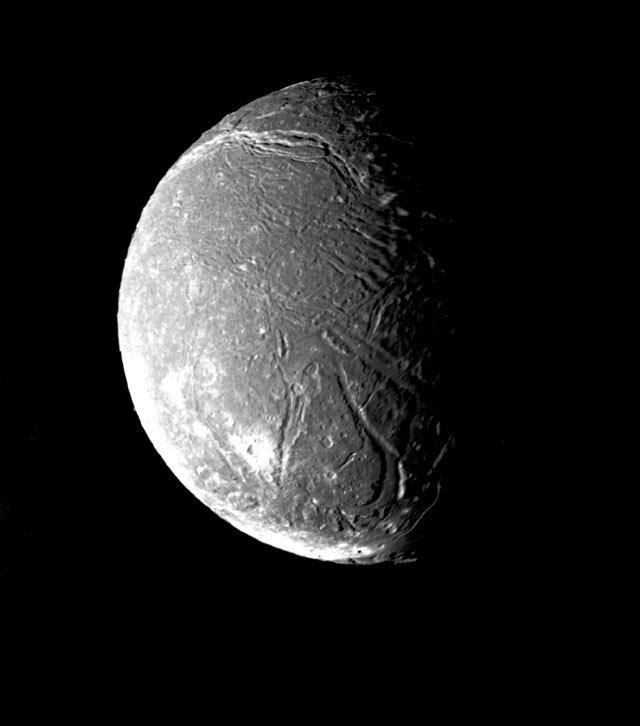
Highest-resolution picture of Titania displays prominent fault valleys nearly 1,000 miles long. January 24, 1986. Range, 229,000 miles.
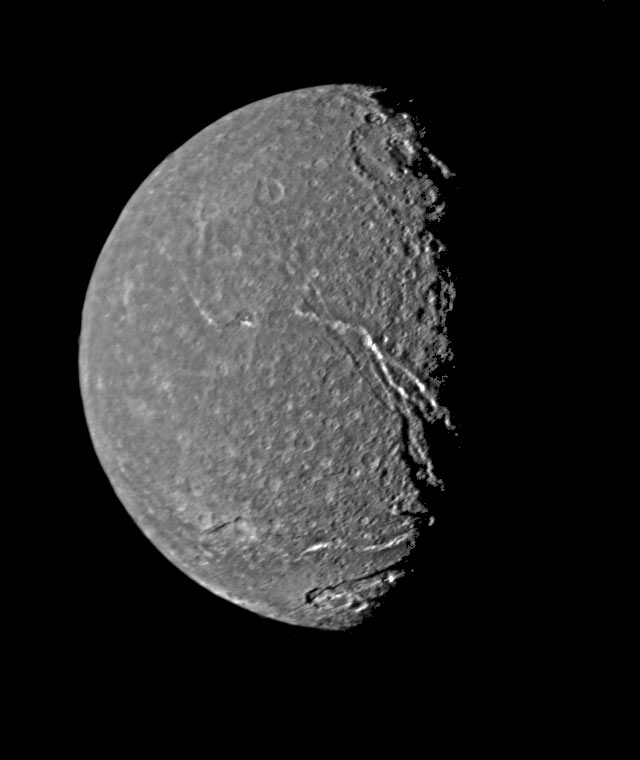
Color composite shows evidence of impact scars and past geologic activity on Titania. January 24, 1986. Range, 300,000 miles.
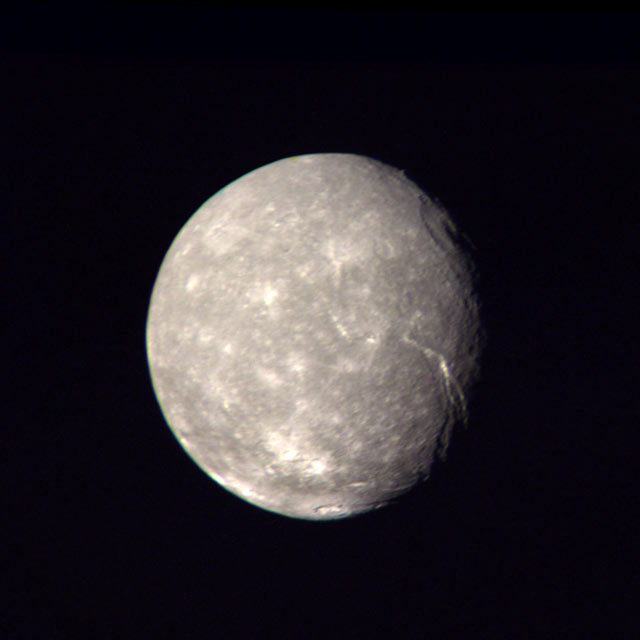
Computer mosaic of Miranda images shows varied geologic regions at high resolution. January 24, 1986.
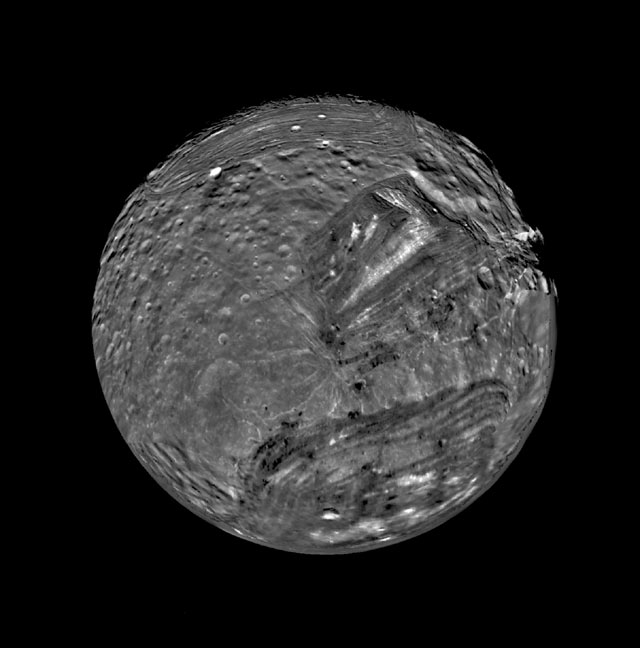
Unusual "Chevron" figure seen on approach to Miranda. January 24, 1986. Range, 26,000 miles.
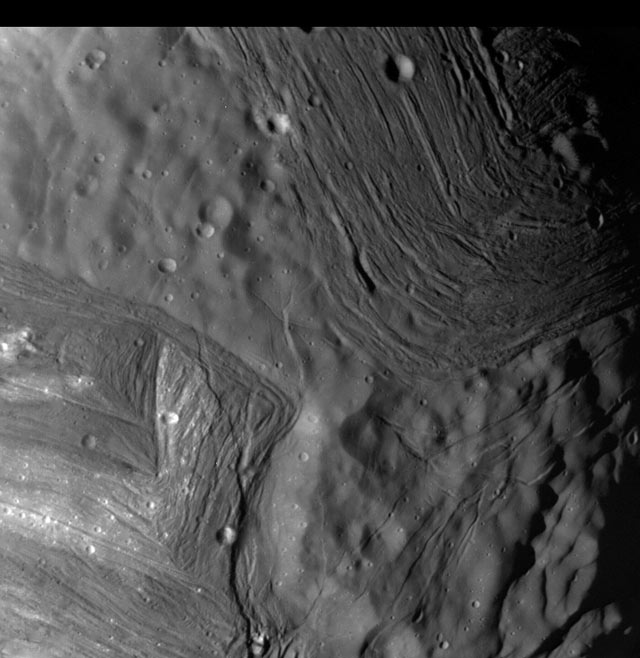
Varied terrain on Miranda indicates complex geologic history. January 24, 1986. Range, 21,000 miles.
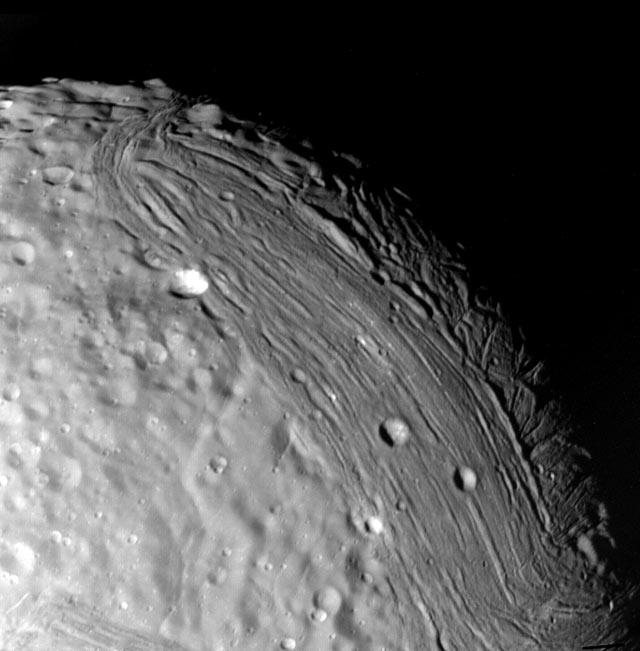
Voyager 2 image of Miranda taken shortly before closest approach. January 24, 1986. Range 19,000 miles.
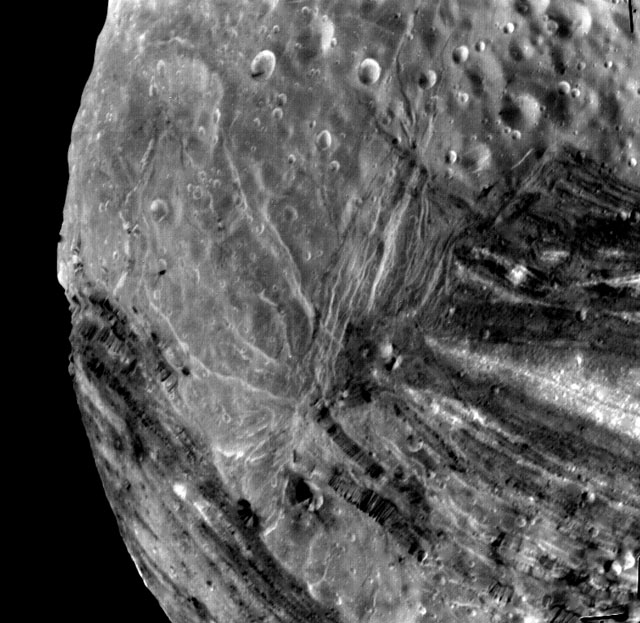
Miranda displays rugged, high-elevation terrain (right), lower, grooved terrain and large crater (lower left) 15 miles across. January 24, 1986. Range, 22,000 miles.
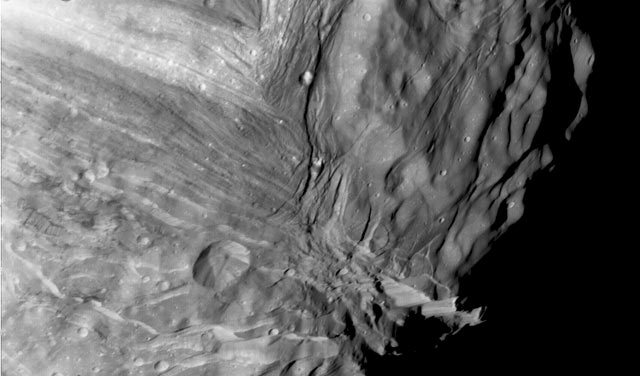

IMAGES
VIDEO
COMMENTS
On Feb. 14, 1990, NASA's Voyager 1 probe snapped a photo of Earth from 3.7 billion miles (6 billion kilometers) away. The image shows our home planet as it truly is — a tiny, lonely outpost of ...
All Orientations. All Sizes. Download and use 900+ Voyage stock photos for free. Thousands of new images every day Completely Free to Use High-quality videos and images from Pexels.
This narrow-angle color image of the Earth, dubbed 'Pale Blue Dot', is a part of the first ever 'portrait' of the solar system taken by Voyager 1. The spacecraft acquired a total of 60 frames for a mosaic of the solar system from a distance of more than 4 billion miles from Earth and about 32 degrees above the ecliptic.
1720x1720x3. PIA18182: Uranus as seen by NASA's Voyager 2. Full Resolution: TIFF (8.879 MB) JPEG (78.82 kB) 1989-10-02. Triton. Voyager. 932x1884x1. PIA14448:
Early Voyager 1 Images of Jupiter Full Resolution: TIFF (491.5 kB) JPEG (21.78 kB) 1996-09-26: Jupiter: Voyager: Imaging Science Subsystem: 400x400x3: PIA00029: First Close-up Image of Jupiter from Voyager ...
Each Voyager space probe carries a gold-plated audio-visual disc in the event that the spacecraft is ever found by intelligent life forms from other planetary systems. Examine the images and sounds of planet earth. Images Voyager Took The Voyager 1 and 2 spacecraft explored Jupiter, Saturn, Uranus and Neptune before starting their journey ...
Browse 1,312,371 voyage photos photos and images available, or start a new search to explore more photos and images. of 100. Browse Getty Images' premium collection of high-quality, authentic Voyage Photos stock photos, royalty-free images, and pictures. Voyage Photos stock photos are available in a variety of sizes and formats to fit your needs.
Hd blue wallpapers chamonix. le brevére. Palm tree pictures & images Florida pictures & images Beautiful pictures & images. daugava pirate vehicle. ship Hq background images Hd wallpapers. sunglasses swimming pool. Download the perfect voyage pictures. Find over 100+ of the best free voyage images. Free for commercial use No attribution ...
of 100. United States. Browse Getty Images' premium collection of high-quality, authentic Voyage stock photos, royalty-free images, and pictures. Voyage stock photos are available in a variety of sizes and formats to fit your needs.
When Voyager 1 and Voyager 2 launched into space in 1977, their mission was to explore the outer solar system, and over the following decade, they did so admirably.. With an 8-track tape memory ...
Voyager Images from the Odysseys (NASA Space Photos) Reflections on the Pale Blue Dot. Voyager 1 Experiences Three "Tsunami Waves" in Interstellar Space. Message to Voyager: Welcome to Interstellar Space ... Voyager at 40: Keep Reaching for the Stars. Voyager 2: First Spacecraft at Neptune. Voyager 2: First Spacecraft at Uranus.
The Pale Blue Dot is a photograph of Earth taken Feb. 14, 1990, by NASA's Voyager 1 at a distance of 3.7 billion miles (6 billion kilometers) from the Sun. The image inspired the title of scientist Carl Sagan's book, "Pale Blue Dot: A Vision of the Human Future in Space," in which he wrote: "Look again at that dot.
Download and use 900+ Voyage, stock photos for free. Thousands of new images every day Completely Free to Use High-quality videos and images from Pexels. Photos. Explore. License. Upload. Upload Join. Free Voyage, Photos. Photos 913 Videos 187 Users 162. Filters. All Orientations.
This is an image of the planet Uranus taken by the spacecraft Voyager 2 in 1986. Credit: NASA/JPL-Caltech. Full Image Details. This image, taken by NASA's Voyager 2 early in the morning of Aug. 23, 1989, is a false color image of Triton, Neptune's largest satellite; mottling in the bright southern hemisphere is present.
420 Free photos of Voyage. Voyage and travel high resolution images. Find your perfect picture for your project. trip voyage journey. traveler traveller. sailboat travel. boat nature sea. fjord sea coast. cruise ship traditional. plane flight airplane. map voyage cartography. hot air balloon clouds. ship cruise ship travel.
In the summer of 1989, NASA's Voyager 2 became the first spacecraft to observe the planet Neptune, its final planetary target. Passing about 4,950 kilometers (3,000 miles) above Neptune's north pole, Voyager 2 made its closest approach to any planet since leaving Earth 12 years ago. Five hours later, Voyager 2 passed about 40,000 kilometers ...
Voyager spacecraft in front of the Milky Way galaxy and a bright nearby star in deep space (3d illustration, elements of this image are furnished by NASA) Find Voyage stock images in HD and millions of other royalty-free stock photos, 3D objects, illustrations and vectors in the Shutterstock collection. Thousands of new, high-quality pictures ...
Download and use 10,000+ Ship Voyage stock photos for free. Thousands of new images every day Completely Free to Use High-quality videos and images from Pexels
Voyage photo, Stage photo autour du monde. Partez en voyage avec un photographe professionnel, recevez ses conseils et développez votre regard photographique . Open Graph Description. Open Graph Description. 01 45 04 05 98 . L'Agence . Nos carnets de voyage . Offrir . Mes Envies . 01 45 04 05 98 . VOYAGE PHOTO . Monde . EUROPE . ASIE .
Solar System Portrait. This narrow-angle color image of the Earth, dubbed 'Pale Blue Dot', is a part of the first ever 'portrait' of the solar system taken by Voyager 1. The spacecraft acquired a total of 60 frames for a mosaic of the solar system from a distance of more than 4 billion miles from Earth and about 32 degrees above the ecliptic.
NASA's Perseverance Mars rover captured this image of a sample cored from a rock called "Bunsen Peak" on March 11,… NASA's Curiosity Rover Reaches Gediz Vallis Channel (360 View) 360-degree panorama provided by NASA's Curiosity Mars rover. This view was captured at Gediz Vallis channel ...
Download and use 4,117+ Voyage photo stock videos for free. Thousands of new 4k videos every day Completely Free to Use High-quality HD videos and clips from Pexels. Videos. Explore. License. Upload. Upload Join. Free Voyage Photo Videos. Photos 31.5K Videos 4.1K Users 10.7K. Filters. Popular. All Orientations. All Sizes.
NASA's Voyager 2 spacecraft flew closely past distant Uranus, the seventh planet from the Sun, in January. At its closet, the spacecraft came within 81,800 kilometers (50,600 miles) of Uranus's cloudtops on Jan. 24, 1986. Voyager 2 radioed thousands of images and voluminous amounts of other scientific data on the planet, its moons, rings ...